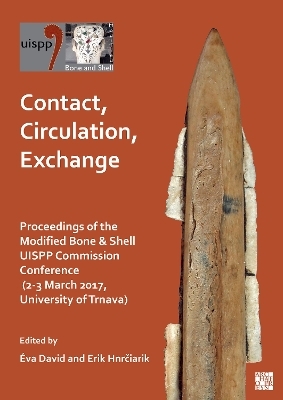
Contact, Circulation, Exchange
Proceedings of the Modified Bone & Shell UISPP Commission Conference (2-3 March 2017, University of Trnava)
Seiten
2023
Archaeopress Archaeology (Verlag)
978-1-80327-595-6 (ISBN)
Archaeopress Archaeology (Verlag)
978-1-80327-595-6 (ISBN)
10 articles focus on worked hard materials of animal origin (shell, tusk, bone, antler) ranging chronologically from the Upper Palaeolithic to the Middle Ages. The authors have varied academic backgrounds that enhance the archaeological analyses carried out, often at first hand, on numerous collections from the Old and New Worlds.
Contact, Circulation, Exchange collects ten articles focusing on worked hard materials of animal origin (shell, tusk, bone, antler) ranging chronologically from the Upper Palaeolithic to the Middle Ages. The authors have varied academic backgrounds that enhance the archaeological analyses carried out, often at first hand, on numerous collections from the Old and New Worlds.
Evidence of contact between past populations with distinct technical traditions is found in the dynamic imposed by using certain craft methods, such as stone pressure flaking (7,000 BC). Another kind of stimulus may have given rise to a tool with a specific use in the migration period, the sumak (300 BC-600 AD). Apart from the attraction of a novel technique or a new piece of equipment, it was the attraction of the raw material and the hunting sites that formed the guiding principle behind the mobility of groups within a territory, in early (35,000-12,000 BC) as in recent prehistory (up to 1500 AD).
Weaponry, adornments and/or the animal species used are then powerful markers of the extent of trade routes and networks, and even of craftsmanship when related to village settlements (4,500-2,500 BC). In antiquity, the exotic rather than exogenous origin of materials was used to develop unique skills in the service of cults. In the diffusion of figurines, representation took precedence over the unique or sought-after nature of the material, whose origin remained nonetheless animal.
Contact, Circulation, Exchange collects ten articles focusing on worked hard materials of animal origin (shell, tusk, bone, antler) ranging chronologically from the Upper Palaeolithic to the Middle Ages. The authors have varied academic backgrounds that enhance the archaeological analyses carried out, often at first hand, on numerous collections from the Old and New Worlds.
Evidence of contact between past populations with distinct technical traditions is found in the dynamic imposed by using certain craft methods, such as stone pressure flaking (7,000 BC). Another kind of stimulus may have given rise to a tool with a specific use in the migration period, the sumak (300 BC-600 AD). Apart from the attraction of a novel technique or a new piece of equipment, it was the attraction of the raw material and the hunting sites that formed the guiding principle behind the mobility of groups within a territory, in early (35,000-12,000 BC) as in recent prehistory (up to 1500 AD).
Weaponry, adornments and/or the animal species used are then powerful markers of the extent of trade routes and networks, and even of craftsmanship when related to village settlements (4,500-2,500 BC). In antiquity, the exotic rather than exogenous origin of materials was used to develop unique skills in the service of cults. In the diffusion of figurines, representation took precedence over the unique or sought-after nature of the material, whose origin remained nonetheless animal.
The editors and authors of this book are all members of the Modified Bone & Shell Commission of the UISPP. The aim of this commission is to promote and disseminate knowledge about the use and manufacture of bone materials in past societies. Éva David, who heads the commission and holds a doctorate in comparative sociology, is developing research into prehistoric bone industries at the National Centre for Scientific Research (CNRS), where she is also editor of a collection on the anthropology of Stone Age techniques. Erik Hnrčiarik, who holds a doctorate in classical archaeology, recently published the Roman bone artefacts from Iža excavated by the Archaeological Institute of the Slovak Academy of Sciences.
| Erscheinungsdatum | 12.09.2023 |
|---|---|
| Reihe/Serie | Union Internationale des Sciences Préhistoriques et Protohistoriques |
| Verlagsort | Oxford |
| Sprache | englisch |
| Maße | 205 x 290 mm |
| Gewicht | 674 g |
| Themenwelt | Geisteswissenschaften ► Archäologie |
| Geschichte ► Allgemeine Geschichte ► Vor- und Frühgeschichte | |
| ISBN-10 | 1-80327-595-2 / 1803275952 |
| ISBN-13 | 978-1-80327-595-6 / 9781803275956 |
| Zustand | Neuware |
| Informationen gemäß Produktsicherheitsverordnung (GPSR) | |
| Haben Sie eine Frage zum Produkt? |
Mehr entdecken
aus dem Bereich
aus dem Bereich
Was Pompeji über uns erzählt
Buch | Hardcover (2023)
Propyläen (Verlag)
32,00 €
auf den Spuren der frühen Zivilisationen
Buch | Hardcover (2023)
C.H.Beck (Verlag)
20,00 €


